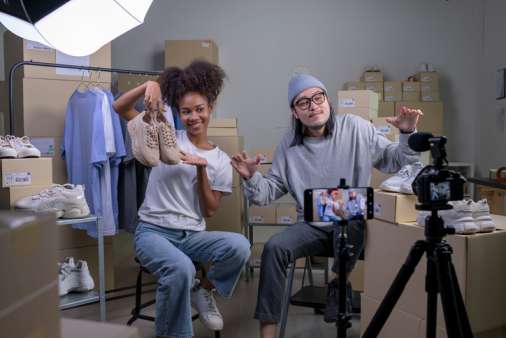My mother loves to shop online. Recently, she was introduced to live shopping, and it changed the way she buys.
She enjoys exploring new products, brands, and creators. One day, her favorite creator went live on Amazon – selling products, giving demos, and creating an engaging experience.
She liked what they sold, clicked the product link, and bought it.
In short, that’s livestream shopping commerce in action.
Today, live shopping USA is booming, with brands and creators pouring money and energy into it. In fact, in 2023 alone, live commerce sales in the US were estimated to be worth $50 billion.
According to Statista, livestream commerce will grow by 36%, accounting for 5% of all e-commerce sales in North America by 2026.

What is Live Shopping?
Live shopping, also known as live commerce, and livestream shopping, blends video, entertainment, and e-commerce.
A simple live shopping definition is this: it’s the use of live video to demonstrate and sell products directly to consumers. In other words, shoppers buy while they watch.
You might ask, “What is livestream shopping?” It’s the same idea – combining the energy of a broadcast with instant purchasing, making it possible to shop in real time.
Brands use this format as part of video commerce to promote and sell products through live broadcasts on digital platforms, typically in partnership with influencers or hosts. Platforms like Amazon Live serve as a video shopping platform, where viewers can engage with creators, ask questions, and buy products instantly.

Image: Amazon Live with host featuring products on sale
Unlike traditional e-commerce that uses static images and text-based descriptions, live shopping creates a personalized, engaging, and interactive experience.
How Did Live Shopping Become What It Is Today?
To answer this question, let’s give you a bit of historical context.
From TV to Online
Live shopping is not entirely new.
It draws inspiration from TV shopping channels.
The early 2000s saw the rise of livestreaming shopping.
Remember Home Shopping Network shows from the past?
Back then, brands would partner with HSN to promote their products. The host would then show the product in action, give live demos. And, a contact number would appear on the screen allowing viewers to place orders or get live assistance.

Image credit: @HyperTV1 on YouTube
As years passed by, live commerce on television channels was replaced by online mediums. Eventually, this shift led to livestream platforms like Taobao.
Taobao and China’s Livestream Boom
The contribution of Chinese retail giant Taobao is perhaps the most important one in the evolution of live video stream shopping as we see it today.
In 2016, Alibaba’s Taobao launched the first livestream shopping event.
As the Singles’ Day pre-sales campaign in 2020 on Taobao Live generated US$7.5 billion in total transaction value in the first 30 minutes, it made headlines all over the world.
In the same year, the total sales revenue of Taobao, Kuaishou, and Douyin reached US$140 billion.
The U.S. Catches On
Excited by the success of selling live in China, companies in the US became eager to replicate the same magic on their home turf.
Then came the COVID-19 pandemic which further boosted its growth, allowing buyers to shop from the comfort of their home.
Now TikTok, Amazon, Walmart, YouTube are all in the game.
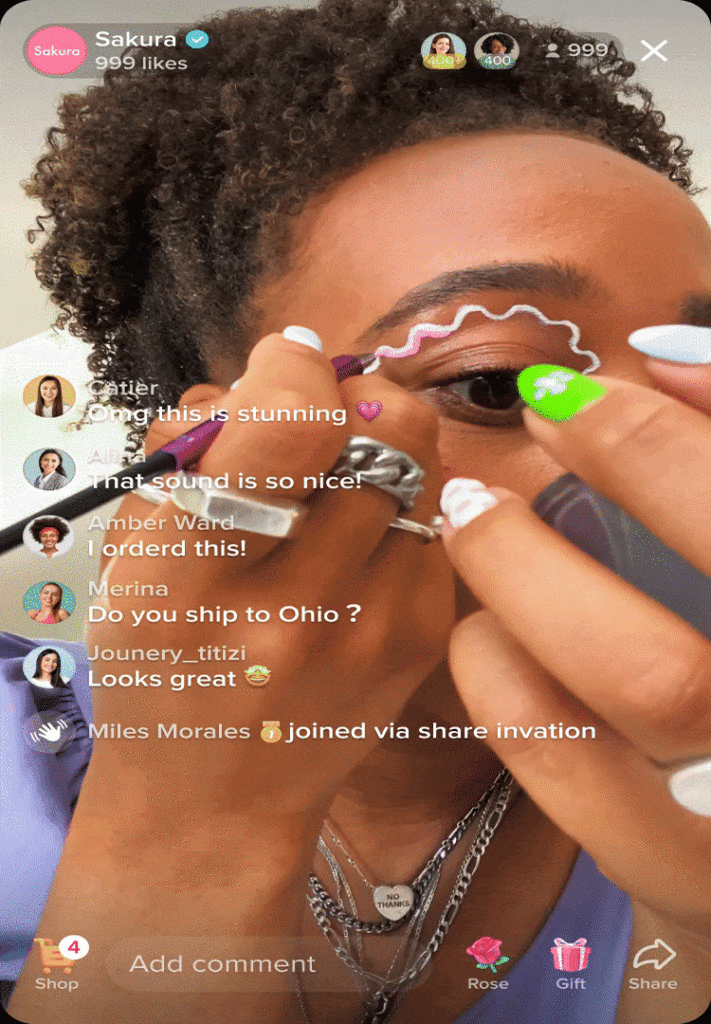
Clip: TikTok
TikTok recently hosted “Deals For You Days” where creators and brands came together to sell live on the social media platform.
Here’s what they announced before the event began on July 9, 2024:
Starting on July 9, trending brands like L’Oréal Paris, Maybelline New York, NYX Professional Makeup, Our Place, Too Faced, and Zwilling USA are offering huge savings exclusively on TikTok Shop in the US. Merchants and creators can participate in content challenges for short video and LIVE shopping events, where they can interact directly with their followers and share their favorite products and best-sellers.
Similarly, YouTube also allows sellers to connect their stores, tag items, and broadcast shoppable livestreams on its platform.
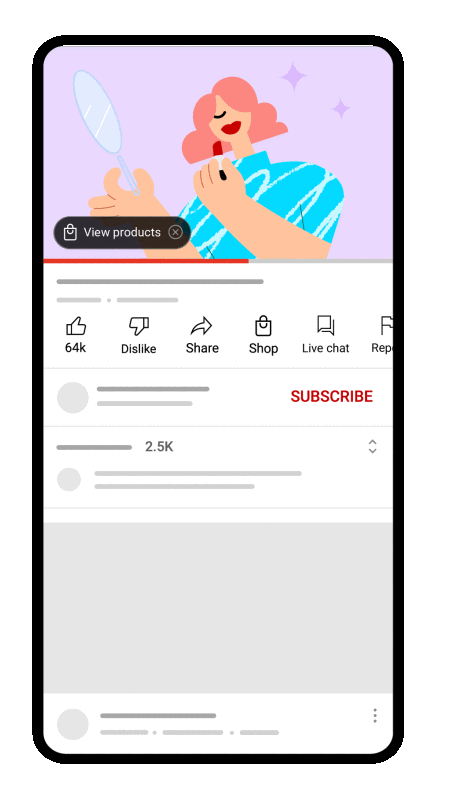
Clip: How live commerce works on YouTube | Credit: YouTube
Buyers can click the “Shop” button for products in this livestream which will then open a list of featured products, and checkout immediately without leaving YouTube.
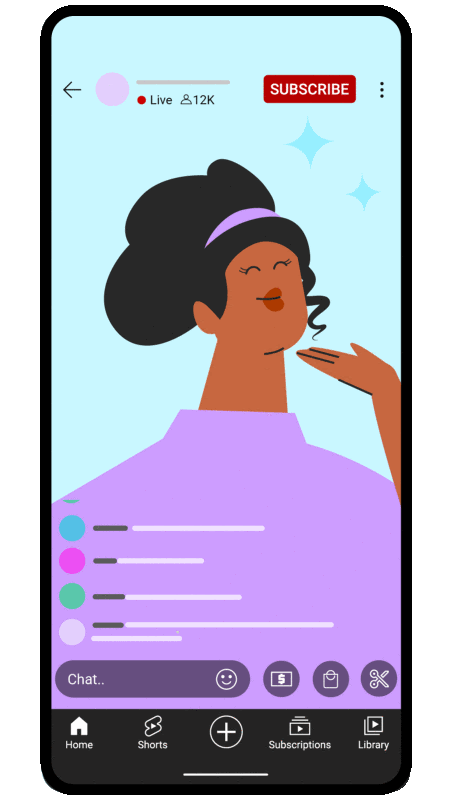
Clip credit: YouTube
The product section above the watch feed lets customers shop for featured products even when live chat is closed.
More retailers and brands have jumped the bandwagon to start their own live events on their own websites.

Image: Screengrab showing a past live shopping session on Avon’s website
| DID YOU KNOW? With Vimmi, you can go live on multiple platforms including, TikTok, YouTube, website storefronts, and marketplaces like Amazon at the same time. |
How Does Video Shopping Work?
The basics of video shopping are simple.
In a live shopping event, hosts present products in real-time, give a demo, and interact with viewers. They might even share exclusive, time-bound promo codes to boost sales.
Viewers can interact with the host through live chat, ask questions, participate in polls, and make purchases directly from the stream.

Image: A host on Amazon Live featuring COFANDY products
Most events take place on a live video shopping platform. Some brands use a live stream shopping platform to go live on TikTok, Instagram, or YouTube at the same time.
This direct interaction not only keeps viewers engaged but also builds a connection between the host and the audience, offering a seamless blend of entertainment and shopping. In addition, it increases buying confidence.
Key Elements of a Live Shopping Experience
- A live shopping platform
- A host and/or co-hosts
- A participating brand
- Products that will be showcased during the event
- Interactive features, such as live chat, polls, or Q&A sessions.
- Shoppable product links
Some brands use multiple live shopping platforms at once to expand reach and maximize the impact of their live shopping experience.
Benefits of Live Shopping
1. Better Customer Engagement
The live format allows for immediate feedback and interaction, making viewers feel involved and valued. Moreover, it builds trust between host and audience, making online live selling more engaging than static e-commerce.
Customers see another human being on the side of the screen. As a result, they have someone to talk to, who can answer their questions, clarify doubts. That’s the power of live online selling – real people creating real trust in real time.
Look at this image below and see how interested buyers are chatting, asking questions, and interacting with the host:

2. Drives FOMO and Impulse Buying
The combination of real-time product demonstrations and interactive formats, such as exclusive coupons, flash sales with a countdown timer, drive FOMO and impulse buying.
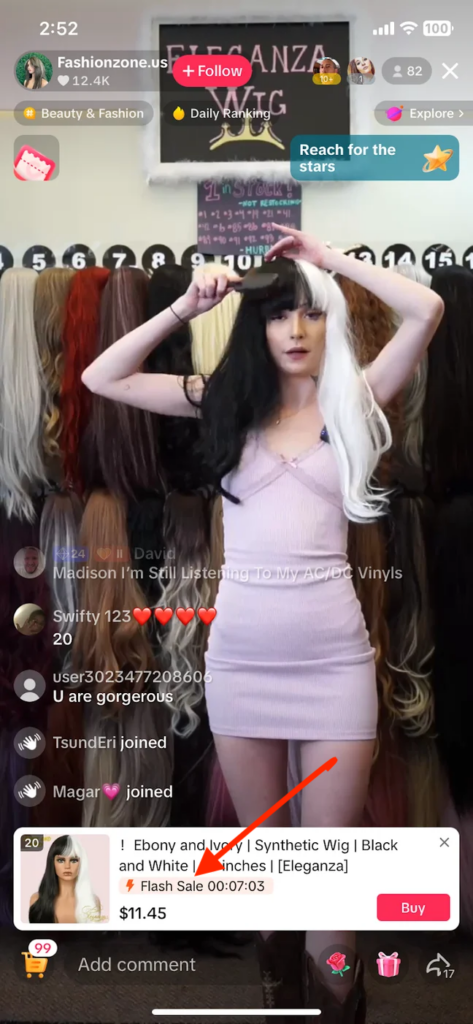
Image credit: Hubspot
3. Reusable Content
Live videos aren’t only useful during the event. Brands can make recorded sessions available to those buyers who missed the show or want to watch later.
This screengrab is from a past live shopping event hosted on Avon’s website that still allows buyers to play it and buy from the shoppable links after it ended.
Notice there’s also a library of recorded livestream events below that.
These are a type of shoppable videos.
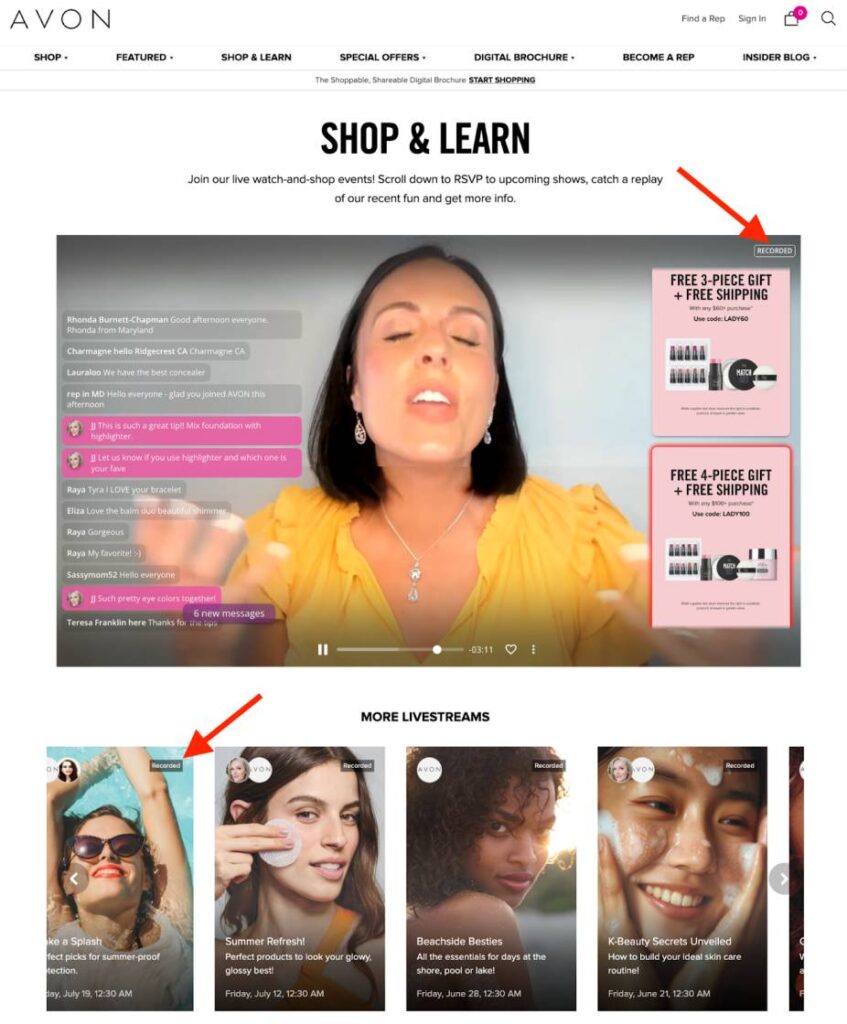
4. Boosts Sales
Stormi Steele, founder of Canvas Beauty, on June 8th, 2024, earned $1 million in sales during a 6-hour livestream on TikTok.
Companies using live commerce have reported conversion rates as high as 30%, compared to the 2.5–3% average for standard e-commerce.
Taobao claims their conversion rates are 32%.
5. Builds Trust and Authenticity
Trust is everything in e-commerce.
With live shopping, customers can watch the product in action, ask questions, and get honest answers on the spot.
This transparency and authenticity builds trust and shows you have nothing to hide.
6. Fuels the Creator Economy
Livestreaming commerce is powering the growth of creators and small businesses. It lets creators, influencers, and small businesses make money and grow their brands.
With live shopping, they can show off products, earn affiliate commissions, land more sponsorships, and build authority.
Future Trends in Live Video Shopping
1. Integration of AR/VR
Augmented reality (AR) and virtual reality (VR) are already being used. In the coming years, we expect to see more AR/VR fusions and creativity. These are some of the biggest live shopping trends shaping the industry.
2. Omnichannel Livestreaming
Wouldn’t it be awesome if you could livestream everywhere at the same time? Omnichannel livestreaming shopping blends live shopping with multiple marketing channels.
At Vimmi we believe in experiencing the future in the present, so we’ve already enabled this for our users.
Go live and stream everywhere – your website, TikTok, Amazon, Walmart, YouTube, Instagram, Facebook, Twitch – all at the same time. Leading live shopping companies are already testing these tools to expand reach.
3. One-to-One Live Shopping
One-to-one video calls are trending for high-value purchases, allowing shoppers to connect with creators in real-time.
In other words, it’s like bringing the in-store experience to your screen with personalized advice and recommendations.
Luxury brands have seen great success with this. Therefore, we expect to see growing demand for one-to-one live shopping events.
Final Thoughts
Live shopping ecommerce is here to stay and transform online retail.
The sooner you start investing in livestream shopping, the better it is for boosting sales and staying ahead of the competition.
For consumers, live shopping online is fun and interactive. For brands, it’s one of the fastest ways to grow.
Share your experiences or ask questions in the comments below – let’s continue the conversation.
